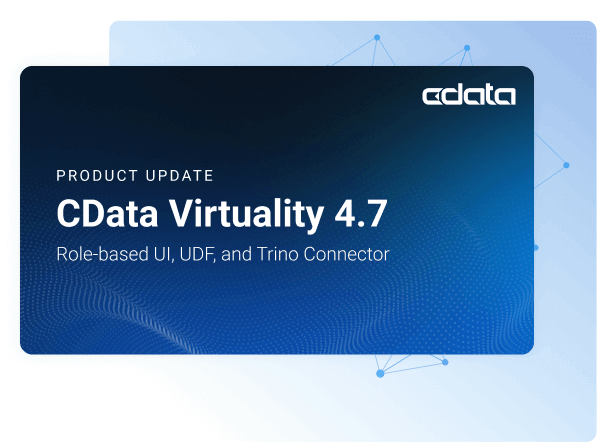Discover how a bimodal integration strategy can address the major data management challenges facing your organization today.
Get the Report →How to Connect to Amazon Athena Data in Python on Linux/UNIX
Create Python applications on Linux/UNIX machines with connectivity to Amazon Athena data. Leverage the pyodbc module for ODBC in Python.
The rich ecosystem of Python modules lets you get to work quicker and integrate your systems more effectively. With the CData Linux/UNIX ODBC Driver for Amazon Athena and the pyodbc module, you can easily build Amazon Athena-connected Python applications. This article shows how to use the pyodbc built-in functions to connect to Amazon Athena data, execute queries, and output the results.
Using the CData ODBC Drivers on a UNIX/Linux Machine
The CData ODBC Drivers are supported in various Red Hat-based and Debian-based systems, including Ubuntu, Debian, RHEL, CentOS, and Fedora. There are also several libraries and packages that are required, many of which may be installed by default, depending on your system. For more information on the supported versions of Linux operating systems and the required libraries, please refer to the "Getting Started" section in the help documentation (installed and found online).
Installing the Driver Manager
Before installing the driver, check that your system has a driver manager. For this article, you will use unixODBC, a free and open source ODBC driver manager that is widely supported.
For Debian-based systems like Ubuntu, you can install unixODBC with the APT package manager:
$ sudo apt-get install unixodbc unixodbc-dev
For systems based on Red Hat Linux, you can install unixODBC with yum or dnf:
$ sudo yum install unixODBC unixODBC-devel
The unixODBC driver manager reads information about drivers from an odbcinst.ini file and about data sources from an odbc.ini file. You can determine the location of the configuration files on your system by entering the following command into a terminal:
$ odbcinst -j
The output of the command will display the locations of the configuration files for ODBC data sources and registered ODBC drivers. User data sources can only be accessed by the user account whose home folder the odbc.ini is located in. System data sources can be accessed by all users. Below is an example of the output of this command:
DRIVERS............: /etc/odbcinst.ini
SYSTEM DATA SOURCES: /etc/odbc.ini
FILE DATA SOURCES..: /etc/ODBCDataSources
USER DATA SOURCES..: /home/myuser/.odbc.ini
SQLULEN Size.......: 8
SQLLEN Size........: 8
SQLSETPOSIROW Size.: 8
Installing the Driver
You can download the driver in standard package formats: the Debian .deb package format or the .rpm file format. Once you have downloaded the file, you can install the driver from the terminal.
The driver installer registers the driver with unixODBC and creates a system DSN, which can be used later in any tools or applications that support ODBC connectivity.
For Debian-based systems like Ubuntu, run the following command with sudo or as root:
$ dpkg -i /path/to/package.deb
For Red Hat systems and other systems that support .rpms, run the following command with sudo or as root:
$ rpm -i /path/to/package.rpm
Once the driver is installed, you can list the registered drivers and defined data sources using the unixODBC driver manager:
List the Registered Driver(s)
$ odbcinst -q -d
CData ODBC Driver for Amazon Athena
...
List the Defined Data Source(s)
$ odbcinst -q -s
CData AmazonAthena Source
...
To use the CData ODBC Driver for Amazon Athena with unixODBC, ensure that the driver is configured to use UTF-16. To do so, edit the INI file for the driver (cdata.odbc.amazonathena.ini), which can be found in the lib folder in the installation location (typically /opt/cdata/cdata-odbc-driver-for-amazonathena), as follows:
cdata.odbc.amazonathena.ini
...
[Driver]
DriverManagerEncoding = UTF-16
Modifying the DSN
The driver installation predefines a system DSN. You can modify the DSN by editing the system data sources file (/etc/odbc.ini) and defining the required connection properties. Additionally, you can create user-specific DSNs that will not require root access to modify in $HOME/.odbc.ini.
Authenticating to Amazon Athena
To authorize Amazon Athena requests, provide the credentials for an administrator account or for an IAM user with custom permissions: Set AccessKey to the access key Id. Set SecretKey to the secret access key.
Note: Though you can connect as the AWS account administrator, it is recommended to use IAM user credentials to access AWS services.
Obtaining the Access Key
To obtain the credentials for an IAM user, follow the steps below:
- Sign into the IAM console.
- In the navigation pane, select Users.
- To create or manage the access keys for a user, select the user and then select the Security Credentials tab.
To obtain the credentials for your AWS root account, follow the steps below:
- Sign into the AWS Management console with the credentials for your root account.
- Select your account name or number and select My Security Credentials in the menu that is displayed.
- Click Continue to Security Credentials and expand the Access Keys section to manage or create root account access keys.
Authenticating from an EC2 Instance
If you are using the CData Data Provider for Amazon Athena 2018 from an EC2 Instance and have an IAM Role assigned to the instance, you can use the IAM Role to authenticate. To do so, set UseEC2Roles to true and leave AccessKey and SecretKey empty. The CData Data Provider for Amazon Athena 2018 will automatically obtain your IAM Role credentials and authenticate with them.
Authenticating as an AWS Role
In many situations it may be preferable to use an IAM role for authentication instead of the direct security credentials of an AWS root user. An AWS role may be used instead by specifying the RoleARN. This will cause the CData Data Provider for Amazon Athena 2018 to attempt to retrieve credentials for the specified role. If you are connecting to AWS (instead of already being connected such as on an EC2 instance), you must additionally specify the AccessKey and SecretKey of an IAM user to assume the role for. Roles may not be used when specifying the AccessKey and SecretKey of an AWS root user.
Authenticating with MFA
For users and roles that require Multi-factor Authentication, specify the MFASerialNumber and MFAToken connection properties. This will cause the CData Data Provider for Amazon Athena 2018 to submit the MFA credentials in a request to retrieve temporary authentication credentials. Note that the duration of the temporary credentials may be controlled via the TemporaryTokenDuration (default 3600 seconds).
Connecting to Amazon Athena
In addition to the AccessKey and SecretKey properties, specify Database, S3StagingDirectory and Region. Set Region to the region where your Amazon Athena data is hosted. Set S3StagingDirectory to a folder in S3 where you would like to store the results of queries.
If Database is not set in the connection, the data provider connects to the default database set in Amazon Athena.
/etc/odbc.ini or $HOME/.odbc.ini
[CData AmazonAthena Source]
Driver = CData ODBC Driver for Amazon Athena
Description = My Description
AccessKey = 'a123'
SecretKey = 's123'
Region = 'IRELAND'
Database = 'sampledb'
S3StagingDirectory = 's3://bucket/staging/'
For specific information on using these configuration files, please refer to the help documentation (installed and found online).
You can follow the procedure below to install pyodbc and start accessing Amazon Athena through Python objects.
Install pyodbc
You can use the pip utility to install the module:
pip install pyodbc
Be sure to import with the module with the following:
import pyodbc
Connect to Amazon Athena Data in Python
You can now connect with an ODBC connection string or a DSN. Below is the syntax for a connection string:
cnxn = pyodbc.connect('DRIVER={CData ODBC Driver for Amazon Athena};AccessKey='a123';SecretKey='s123';Region='IRELAND';Database='sampledb';S3StagingDirectory='s3://bucket/staging/';')
Below is the syntax for a DSN:
cnxn = pyodbc.connect('DSN=CData AmazonAthena Sys;')
Execute SQL to Amazon Athena
Instantiate a Cursor and use the execute method of the Cursor class to execute any SQL statement.
cursor = cnxn.cursor()
Select
You can use fetchall, fetchone, and fetchmany to retrieve Rows returned from SELECT statements:
import pyodbc
cursor = cnxn.cursor()
cnxn = pyodbc.connect('DSN=CData AmazonAthena Source;User=MyUser;Password=MyPassword')
cursor.execute("SELECT Name, TotalDue FROM Customers WHERE CustomerId = '12345'")
rows = cursor.fetchall()
for row in rows:
print(row.Name, row.TotalDue)
You can provide parameterized queries in a sequence or in the argument list:
cursor.execute(
"SELECT Name, TotalDue
FROM Customers
WHERE CustomerId = ?", '12345',1)
Insert
INSERT commands also use the execute method; however, you must subsequently call the commit method after an insert or you will lose your changes:
cursor.execute("INSERT INTO Customers (CustomerId) VALUES ('12345')")
cnxn.commit()
Update and Delete
As with an insert, you must also call commit after calling execute for an update or delete:
cursor.execute("UPDATE Customers SET CustomerId = '12345'")
cnxn.commit()
Metadata Discovery
You can use the getinfo method to retrieve data such as information about the data source and the capabilities of the driver. The getinfo method passes through input to the ODBC SQLGetInfo method.
cnxn.getinfo(pyodbc.SQL_DATA_SOURCE_NAME)
You are now ready to build Python apps in Linux/UNIX environments with connectivity to Amazon Athena data, using the CData ODBC Driver for Amazon Athena.






